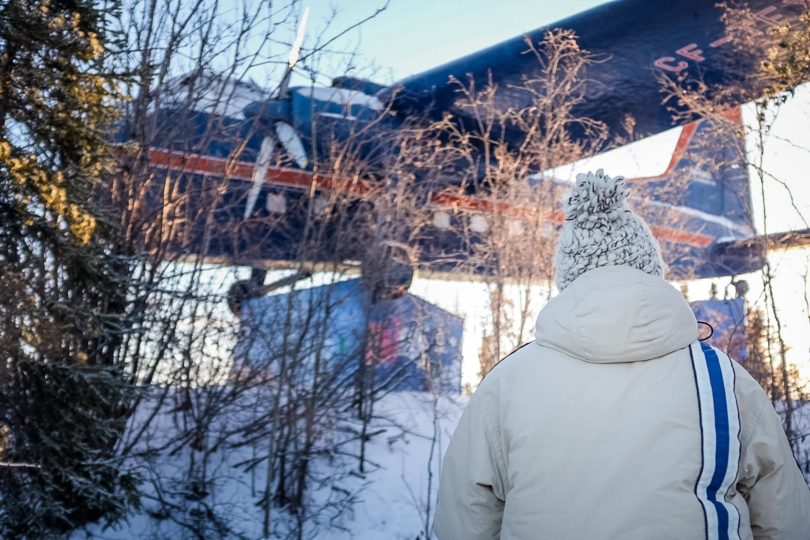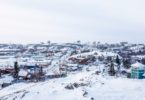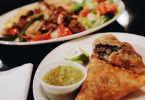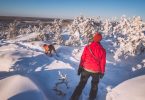Quick facts about Yellowknife in November
Weather, daylight, and Aurora in November
Average Temperature: -14.8°C – Warmest -10.8°C, Coldest -18.9°C
Average Hours of Daylight: 6:57:15 – Shortest 5:44:59, Longest 8:17:24
Average Aurora Observation Nights: 20.8
Tourism Popularity: Low – Many tour operators are shut down for the shoulder season
Welcome, winter, our old friend. November is the start of full on winter. The snow will be on the ground. The weather consistently below 0ºC. Lakes mostly are frozen. And the darkness is taking over. But there is a beauty in it all. It represents more than just that.
Just like you would find hygge in Denmark, November represents SOS in Yellowknife. The start of the Season of Socializing. Where camping trips and weekends out on the big lake have ended, but house parties and social gathers in warm places start to take over. Be it a house, or that neighbourhood pub.
Let’s snuggle into November.
Weather and Climate
As mentioned, November is the first full month of winter after summer. There might be snow in October, but November temperatures are completely below 0ºC making the snow stick and the lake ice freeze.
November is typically when Yellowknife sees most of its snowfall. Yellowknife being a relatively dry climate does not see a lot of annual snowfall but with the change in seasons and the slow-free of the massive Great Slave Lake – which typically takes until late December – the conditions are prime for snowfall.
Second, to only October, November in Yellowknife sees the most cloud cover. This might be obvious as November is also when Yellowknife gets most of its snowfall. It is, however, important to note this when it comes to the Aurora Forecast below.
Lake Ice Safety!
A very important element to note about November is lake ice safety. If you are not a seasoned veteran of a particular area and are not willing to take your own life in your hands please make note of this section.
The lakes around Yellowknife start to freeze in October when the temperature starts to consistently go below 0ºC. For safety purposes, it is recommended that ice needs to be at least 6 inches for a person to walk on. Yellowknife Online has put together an ice safety guide here. Normally most lakes other than Great Slave Lake, Prosperous and Prelude are all safe enough to walk on by the end of November.
If you are a visitor to Yellowknife please check with the City of Yellowknife before going onto any frozen lakes during November.
Aurora Forecast and Viewing
Keeping in mind that November is a shoulder season, it is also a shoulder season for viewing the Aurora Borealis. A simple logical burden in November is that many – probably not all – aurora tour operators shut down in November and they are often the best way to get out of the city to see the Northern Lights.
As mentioned above, November is also one of the cloudiest months in Yellowknife there for making it very hard to view the Aurora Borealis. The collision of solar particles with the earth’s magnetic fields – which causes Aurora Borealis – happens near the edge of the earth’s atmosphere so if there are clouds between the surface of the earth and the edge of the atmosphere the aurora will not be physically visible.
The important thing to note here is even if the Aurora Forecast calls for high aurora activity if it is cloudy you will have a hard time viewing them.
This is all mentioned because according to Astronomy North, the organization that tracks viewable aurora nights throughout the year, November does have a recorded average 19.5 nights of Aurora Borealis. It should be noted that Astronomy North considers any visible aurora a successful aurora sighting. So if there were even 5-minutes of clear skies and visible aurora, it is tracked.
November isn’t a recommended month to visit Yellowknife to view the Aurora Borealis. However, if you are going to come to Yellowknife in November try towards the end of the month, but also be prepared for less than ideal conditions and possibly a logical struggle to find an operating aurora tour.
What to wear in November
November temperatures in Yellowknife to a local are considered a mild. They are not near as bad as January or February, but as it is the first month of winter in Yellowknife everyone is adjusting. The snow also becomes a factor. As does what you are doing outside. For the purposes of this article, we are assuming you might be doing two primary activities, walking around Yellowknife and outside for an extended period of time.
Outside Activity
Outdoor activities being hiking, aurora viewing, etc. You will want to dress in layers. It might not be that cold (in Yellowknife terms) but if you are standing still for an extended period you will want to be ready.
Dress in layers. Your base layer should be skin-tight or close to it so that moisture doesn’t get trapped right against your body. Merino-wool is often hailed as the best material for this, but other synthetic fabrics also work. Avoid cotton.
Your middle layers, note that you can have multiple middle layers, should be something like a long sleeve shirt, flannel shirt and/or a fleece sweater. You want these layers to be very breathable so moisture can escape. We often wear two or three middle layers and add to them as it gets colder.
Your outer layer is referred to as your shell. More often than not in Yellowknife you will notice this being a goose-down Canada Goose jacket. They are by far the best for sitting around and aurora gazing. If, however, you’re actively moving, something lighter might be more ideal. This layer should protect you from the snow and wind but also keep in your body heat.
For snow pants, we go with a simpler two-layer system. A thermal base layer and an outer layer, you can, of course, add middle layers.
Let’s not forget your extremities. You’ll want a windproof hat, or toque, scarf/neck warmer/balaclava, and mitts, not gloves, or at least small gloves with larger mitts over them. Your boots should have good insulation. You will be standing a lot and maybe in the snow. Sorels, Stegers or mukluks are all a good idea. Hiking boots are NOT recommended for long durations outside.
Around Town
Around town is a little easier, especially if you are going in and out of shops and buildings. For this simply wearing your middle and outer layer as mentioned above would be sufficient. A regular shirt, sweater, and your jacket or shell. Hat, mitts are also recommended. Snow pants aren’t necessary unless you want to frolic in the snow, but long johns might be handy. Same goes for winter boots, not necessary, but shoes or hiking boots with good traction will make your adventures more stable.
What if you don’t have any of that and don’t want to buy it? There are places in Yellowknife that rent winter clothing.
Things you can do in November
November will be a tricky month to fill your time because of the crossover in seasons. Here are some – but not all – ideas.
Aurora Viewing
While like mentioned above it isn’t recommended to come to Yellowknife to view the Aurora in November, many of you might already be coming or are already here. Again, many aurora tour operators might not be operating. Please keep that in mind. We do have a guide on how to view the Aurora Borealis yourself. As well as a guide to for the different types of tours you can take.
On Land Outdoor Activities
Technically, if you are the adventurous type, there is nothing stopping you from getting outside and on the land. If you are confident in your abilities to navigate the potentially slippery trails hiking is still an option, as is possibly snowshoeing. Just be careful to avoid unsafe lake ice.
Indoor History and Culture
You might opt to spend your day inside learning about Yellowknife, the Northwest Territories, the local history and culture. To do this you could spend your time wandering the Prince of Wales Northern Heritage Centre – a free Government run museum on the edge of Frame Lake, or take a free guided tour of the Northwest Territory Legislative Assembly Building. For a less common idea of a day inside, stop into the Yellowknife Public Library where you can nestle in and get lost in stories. You could also do some reading on Yellowknife, we have a big list of Yellowknife related books all found at the library.
Yellowknife Community Tour
To explore Yellowknife without slogging through the snow you could book a 2-3 hour Yellowknife tour offered by a few different operators each with their own spin. We offer a Yellowknife Community Tour where we string together stories of Yellowknife history and culture with present-day sights and delights. Navigating through the past and into present-day Yellowknife, with many Point-of-Interest spots along the way.
Explore the Food Scene
Yellowknife is a melting pot of different cultures from all over the North and the World. From Vietnamese and Ethiopian to Northern Fare and just good diner food with a twist. You would need more than a week to successfully eat a different cuisine each day while in Yellowknife. A few local tips might be while the Wildcat Cafe is closed for the winter, Thorton’s does reopen, and while always pretty busy, Bullocks Bistro might not have as big of a line for dinner in November.
Grab a Coffee
Like the abundance of eateries, Yellowknife likes coffee too, local coffee. Sure we have two Tim Hortons, but we love our local shops. Be it Luluz, Javaroma, Birchwood Coffee K’o, Gourmet Cup, Dancing Moose Cafe, Mario’s Marvelous Movie Emporium or Barren Ground Coffee. Yellowknife has your caffeine fix on lockdown.
Annual Community Events
There are no major community events that take place in November but there are a few smaller productions that are delightful to attend.
High School Drama Production
Annually one of the high school drama clubs will put on a drama production towards the beginning of November. Tickets and production information can often be found on the Northern Arts and Cultural Centre website.
Santa Clause Parade
The Santa Clause Parade typically takes place in downtown Yellowknife in the evening of the third Saturday in November.
Bella Dance Nutcracker
The local dance studio will put on an annual production of the Nutcracker as performed by its students. This is a family event that takes places at the end of November or early December. Tickets and more information can also often be found on the Northern Arts and Cultural Centre website.
Things you cannot do in November
November being the shoulder month it there are some obvious things you can not do, but there are some that you can do again come the end of the month
- Ice Fishing (not until the ice is safe)
- Drive on an Ice Road (Only open January-April)
- Dog Sledding (not until more snow and ice is safe)
- Visit the Ice Caves (not until the ice is safe)
- Skiing (not until ice is safe and more snow)
- Snowmobiling (not until more snow and ice is safe)
- Skating on an outdoor rink (not until ice is safe)
- Ski-joring/Kicksledding (not until more snow and ice is safe)
- Kite-skiing (not until more snow and ice is safe)
- Visit the Snowcastle (Only open in March)
- Swim in a local lake
- Camping (campground are closed)
- Go boating, canoeing, or kayaking
Driving Conditions in November
If you have decided to rent a car during your stay in Yellowknife here is a little about the road conditions in and around Yellowknife during November, which vary slightly from December-March.
In the city
In the city, you might notice that many of the roads are not actually plowed down to the asphalt. Instead, the snow is packed down and occasionally graded to keep level. The snow can then be very slick and while the municipality does lay down gravel to create traction you should be more cognizant as a driver while on the road. In November the conditions might be extra slippery due to the potential of the snow slightly melting and freezing due to heat on the roads generated by friction. Here is what you should keep in mind:
When coming to stop or the need to slow down, give yourself more distance than normal. Lightly apply your brakes to slow down. If you slam on your brakes you will most likely break all traction and start sliding, even with ABS and winter tires.
When starting from a complete stop and you notice that your tires are spinning – your speedometer will go up while you’re barely moving – back off the gas pedal. Let your tires get traction and then continue to accelerate.
Be aware of where turning lanes are. Franklin Avenue in the downtown core has 5 lanes. Two lanes going either way, with the outer lanes being metered parking most of the day. The lane in the center of the road, which is often unknown, is the turning lane for the side streets. Be aware and don’t block the flow of traffic.
On the highways
Road conditions on the highways are often very good, except for during and right after a good snowfall – which could be frequent in November. The highways, including Highway 3 and Ingraham Trail, are maintained by the Territorial Government, so are plowed regularly.
Shoulders can be soft though and can easily suck in a vehicle if not careful. You should not be parking on the road along the Ingraham Trail so this should not be a problem.
Slowing down on bends in the road is wise as conditions can still be slick even if plowed.
Do not park on any highway. This is illegal and extremely dangerous for other drivers.
Have something to add? Leave us a comment or send us an email.
Yellowknife by the month is a series we are producing to give you a better idea of what Yellowknife has to offer throughout the year. To learn about what Yellowknife is like in other months follow our tag Yellowknife by the Month.












